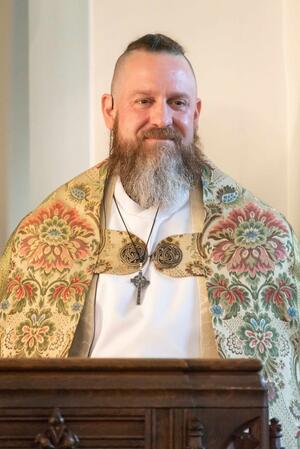By Kim Lawton
Nestled in New York’s Catskill Mountains, St. James Church Lake Delaware has been a landmark in its small, rural community for more than a hundred years. The church was founded by members of the prominent Gerry family, whose ancestors numbered among America’s founders and the real estate tycoons and railroad barons of the Gilded Age. Designed by one of the top church architects of the early twentieth century, St. James’ European-inspired structure has been nationally recognized.
 Yet, in the summer of 2021, St. James’ sole working trustee, Peter Gerry, wrestled with the painful decision of whether he should close the historic church. According to Gerry, who serves on the Dean’s Advisory Council of Yale Divinity School, the congregation had dwindled to just a handful of members—most of them elderly—and the decreasing financial support was not enough to cover the bills. Many other churches in the region were closing or selling off assets to survive, and Gerry feared St. James was headed to a similar fate.
Yet, in the summer of 2021, St. James’ sole working trustee, Peter Gerry, wrestled with the painful decision of whether he should close the historic church. According to Gerry, who serves on the Dean’s Advisory Council of Yale Divinity School, the congregation had dwindled to just a handful of members—most of them elderly—and the decreasing financial support was not enough to cover the bills. Many other churches in the region were closing or selling off assets to survive, and Gerry feared St. James was headed to a similar fate.
“It was really bleak,” he recalls.
But then, Gerry says, the situation turned around in unexpected ways. After hiring a new rector, expanding the ministry vision and amping up community outreach, St. James began experiencing a new vitality that runs counter to recent church trends.
“It feels like a renaissance,” Gerry says.
According to a 2020 survey, the average American Christian congregation size is less than half of what it was in 2000. The survey, spearheaded by the Institute for Religion Research at Hartford International University (formerly Hartford Seminary), also found that “on average, 33 percent of church participants are 65 or older.” Yet, the survey’s report states, “A time of challenge and upheaval can also be a moment of opportunity and revitalization.”
Gerry says that is certainly the case for St. James.
A storied past
Beginning in the 1700s, Gerry’s ancestors acquired thousands of acres of property in the area surrounding St. James. In the late 1800s and early 1900s, Gerry’s great-grandfather, Commodore Elbridge T. Gerry, and his family were often in residence at the family estate there, especially in the summers. According to family lore, Peter Gerry says, the commodore was “quite an authoritarian and became very angry when his children were late” for attending the local Episcopal church. Gerry says, “After being harassed many, many times,” his great aunt Angelica decided, “I’m just going to build a church on the corner of the property.”
And he adds, “She had the resources to do that.”
Angelica Gerry eventually engaged the services of architect Ralph Adams Cram, who was known for his design work on St. John the Divine Cathedral in New York City, the graduate school at Princeton University, and numerous other highly regarded buildings. Construction began in 1922, and the first services were held in the new St. James chapel in October of 1923.
Since its founding, St. James has followed Episcopal liturgical practices and maintained a good relationship with the Episcopal Diocese of Albany. However, Gerry says, the church has never had formal voting ties with the Episcopal denomination. In 1948, Angelica and four nephews set up a trust for the benefit of the church. Since 1985, Gerry has been the principal active trustee.
Facing the challenges
Over the past 30 years, St. James’ membership declined steadily, which meant financial support from the congregation declined as well, even as the costs of maintaining the historic building kept rising.
“We were surviving because we had a pretty nice trust, but it was being expended rapidly,” Gerry says. “It was not sustainable.”
 The situation reached a crisis point in 2021, when the rector who had been hired six months earlier announced he needed to resign due to health concerns. Gerry dreaded having to lead another pastoral search. At that point, active membership was down to less than 10 people.
The situation reached a crisis point in 2021, when the rector who had been hired six months earlier announced he needed to resign due to health concerns. Gerry dreaded having to lead another pastoral search. At that point, active membership was down to less than 10 people.
The departing rector suggested that Gerry speak with his son, the Rev. Paul Moore II, who was ordained but had never led a parish. Moore was the chief executive officer of a nonprofit that distributes medical supplies internationally. Gerry met with Moore, who agreed to at least pinch-hit for his father temporarily. In August 2021, Moore preached his first sermon to a congregation of four people, including the organist, Gerry, and two other congregants.
“At the end of the session, I thought, ‘My God, this is really like preaching to the morgue,’” Gerry recalls. “I figured if he doesn’t stay—and I wouldn’t blame him—I probably would have to shut the whole church down.”
However, Moore says, knowing that St. James had few options, his wife and adult children encouraged him to become the rector. He says they concluded, “If our only job is to make sure that this church doesn’t close … then that’s a calling that’s worthy for us.”
Moore officially became the new rector in October 2021. He immediately switched the Sunday liturgy to a shorter Episcopal rite that was “more accessible” and added some more contemporary songs to the traditional hymns. Instead of the typical brief “Coffee Hour” after church, St. James began serving full meals around a table, and they created special activities organized around fun themes. Moore also strengthened the church’s online presence and began using social media. Moore’s wife, who he calls his “co-director,” became the treasurer and worship leader. His daughter began a children’s program, and his sons performed various roles as well.
Word began to spread. Within the first month, an average of 12 people were attending regularly, and within six months, it was up to 30, including some families with children. Suddenly, St. James leaders had to worry about installing safety gates and a baby changing station. With more people in the pews, financial support increased as well.
 The church also got more involved in the community. Last December, in a nod to St. James’ European inspiration, the church sponsored a hugely popular Christmas market that supported local businesses.
The church also got more involved in the community. Last December, in a nod to St. James’ European inspiration, the church sponsored a hugely popular Christmas market that supported local businesses.
“People bought in” to the vision, says Moore.
St. James now sees between 70 and 100 attenders each week, and on holidays, it is standing room only. Moore’s wife has started a choir, which St. James has not had for many years. The first performance will be on Easter Sunday.
 “It feels like out of all the turmoil and toil … suddenly, it now has a new life, a new spirit,” says Gerry.
“It feels like out of all the turmoil and toil … suddenly, it now has a new life, a new spirit,” says Gerry.
Moore says hope is a key theme in St. James’s story.
“There’s a sense that it’s inevitable that the church is in decline, that there’s nothing we can do, that the situation is hopeless,” Moore says. “But it’s not.”
He adds, “We can be there for each and be welcoming. We’ve just said, ‘Listen. Love God; love each other,’ and that’s what we’re about. And then everything else is the Holy Spirit.”
Kim Lawton is an award-winning reporter, producer, and writer who has worked in broadcast, print and online media. For nearly 20 years, Lawton was Managing Editor and Correspondent for the highly acclaimed national public television program “Religion & Ethics NewsWeekly.”